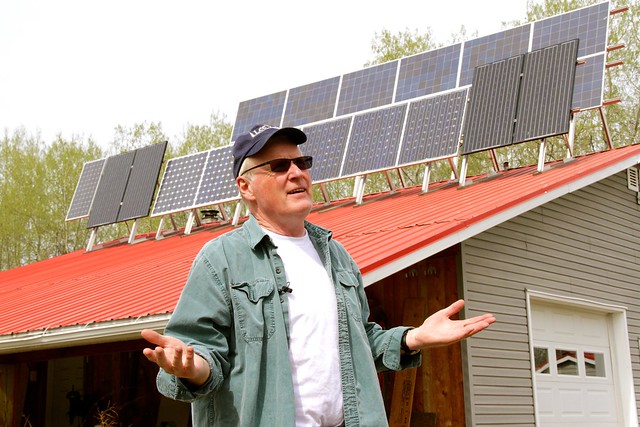By David Dodge & Dylan Thompson
2016 was filled with great and memorable stories for us at Green Energy Futures. It seems like just yesterday we met Bob Chelmick and his dogs at his solar-powered cabin in the woods. I can almost still smell the ocean air around Summerside Prince Edward Island, an energy have-not community that managed to replace almost half of their electricity supply with wind power making it the most successful jurisdiction in North America. We learned how to make a net-zero straw-bale home with Lance and Wendy Olson at Buffalo Lake, Alberta and told the story of how 500 Alberta schools are powered by 100 per cent wind power. From a biogas plant in Lethbridge to a utility that sells energy efficiency into the grid in Nova Scotia we found evidence of a transition to clean energy that is happening from coast to coast.
Join us as we take a look back at our favourite stories of 2016.
The Road Home – solar powered radio
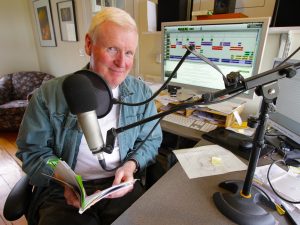
You may know Bob Chelmick as the calm, steady, professional former news anchor from CBC and CTV. But this city boy found his own authenticity in the “calming quiet of the country” where he built his storied solar-powered Cabin in the Woods. Photo David Dodge
Bob Chelmick is a veteran newsman, radio host and award-winning photographer, but it was the story of Bob building his cabin in the woods that captured our interest at Green Energy Futures. Far from the bright lights of the television studio Bob sought refuge in nature when he purchased a quarter section northwest of Edmonton. Disturbed by emissions from the coal plants at Wabamun he built an off-grid, solar powered cabin in the woods.
Bob’s solar powered cabin was his refuge and a place to enjoy nature and poetry and while driving back to the city from the lake “it was a magic time” that became “the road home” and the inspiration for his radio series that blends nature, a strong sense of place and poetry.
“I wanted to integrate the things I love in my life most. Living here in a cabin, living out of the city, living in nature, making radio, storytelling, and painting pictures through that storytelling.”
“I hesitate to use the P-word, but I’m going to,” says Chelmick. “For people who haven’t heard The Road Home (on CKUA radio) and who have been brought up in normal schooling, poetry is a nasty word. I discovered the beauty of poetry when I was a teenager and started reading it and exploring it that way. I’ve always wanted to integrate it on radio, because when it’s presented as an oral art form, it really sings.”
The Road Home is not a poetry show per se. It incorporates storytelling, music, poetry, and Chelmick’s smooth baritone to create something that resists being sorted into a neat little box. Watch the video and you too will literally be transported to Bob’s near mythical cabin in the words, just as we were.
Lethbridge Biogas – transforming brown to green
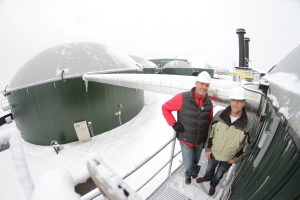
Stefan Michalski (left) and Ed Mulder on a catwalk near the top of the last storage tank in a chain of three 3.9 million litre biogas digesters that harvest methane from manure and organic good wastes. The methane is then burned to generate clean electricity. Photo David Dodge
Next up is a story that may not smell great, but leaves a lot to chew on.
Lethbridge Biogas is located in Southern Alberta. It’s an anaerobic digestion facility. This means they take animal manure, food waste, and much more and “digest” it capturing methane which they use to produce enough electricity to power 3,000 homes.
I know what you’re thinking, “burning methane? How is that green energy?!” Well, it’s important to keep in mind that methane is about 25 times more potent as a greenhouse gas than C02. This means, rather than letting the methane from cow poop enter the atmosphere, it is captured. This results in a 25-fold reduction in GHG emissions.
The best part? After the process is completed, what’s left over can still be spread over a farmer’s crops, but without releasing climate changing methane.
“[The farmer] has a product now that doesn’t stink as much,” says Sefan Michalski of Lethbridge Biogas. “A product that’s better balanced, that has a better nutrient and phosphor-nitrogen ratio. He can deal with it the same way he dealt with the manure before.”
Bull Creek wind farm
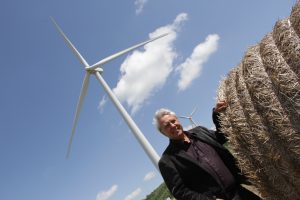
“We are an educational institution, we want to teach kids about that too. We’re an oil producing province but we also know we need to diversify it. So, we like being part of that.” Photo David Dodge,
This time of year is all about coming together and pooling our resources to make something special.
That’s the same kind of spirit that lead to the creation of the Bull Creek wind farm. To become reality, 26 rural Alberta school boards representing 500 schools pooled their resources and struck a deal that will save them money and save the environment.
“A wind farm like this, or in fact many other projects that have a large capital up front cost, are funded with equity and debt … the long-term contracts allowed us to get very, very competitive debt on the project, which brought the price of power down,” says Grant Arnold, CEO of BluEarth Renewables.
Powering schools with 100 per cent renewable energy was the right thing to do says Lorne Young with St Paul Education Regional Division No. 1 .
“The initial investment that we make into it over the 25 year period, there will be a dividend paid back that will far exceed what our initial investment is. As I said the predictability on the cost side of power is a huge thing for us and the educational value of being part of a renewable energy project…So, at the end of the day it was one of those projects that we just wanted to get behind.”
Schools as models of sustainability, it’s what the boards were looking for and what students want to see more of as we learned in another story we did on students writing a white paper on climate change in education.
Summerside, PEI – energy transition on steroids
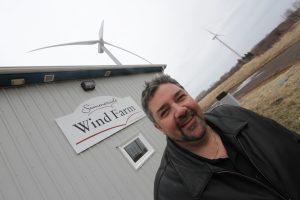
Greg Gaudet, director of municipal services at the Summerside P.E.I. wind farm–the City went from diesel power to wind power in less than 10 years and today gets 46% of its electricity from wind power. Photo David Dodge
Never has the expression necessity is the mother of invention been more apropos. This small city in Prince Edward Island replaced very expensive, polluting diesel power generation with wind power in less than five years.
Summerside has achieved a record 46 per cent integration of wind power onto their grid. What’s even more impressive is how quickly they did this. A decade ago, Summerside, and much of PEI had some of the dirtiest and most expensive electricity in the country. That’s because they got most of it from diesel generators and through imports. They built their own wind farm which got them 25 per cent of their electricity from wind power, and then they built a smart grid and used energy storing appliances to take it to 46 per cent wind power, one of the highest integration rates in North America.
Oh and the wind power was by far the cheapest way for them to produce electricity locally.
Efficiency Nova Scotia – selling negawatts

Efficiency Nova Scotia is the first utility in Canada that exclusively sells energy efficiency (“negawatts”) into the grid. Saving energy costs one quarter of the price of generating new energy in Nova Scotia and returns $110 million dollars into the hands of Nova Scotia residents and businesses. Supplied: Efficiency NS
EfficiencyOne in Nova Scotia is the first utility in Canada that sells energy efficiency into the grid. Some call this “negawatts.”
In 2015 Efficiency Nova Scotia put $110 million back into the pockets of residents and small businesses of Nova Scotia by selling energy efficiency into the grid for about three cents per kilowatt hour, about one quarter the price of electricity in this Atlantic Province.
Since their inception, Efficiency Nova Scotia has recycled more than 31,000 inefficient appliances. They’ve also supported consumers with purchasing replacements through in-store rebates on high-efficiency appliances.
In 2014 alone, Efficiency Nova Scotia retrofitted the insulation or draft-proofing of 160 low-rent apartment buildings. They’ve also supported the construction of over 4,000 energy-efficient homes.
“If you think about Nova Scotia as being one big electricity bill, electricity costs are $110 million lower in 2016, than they otherwise would have been,” says Stephen MacDonald, CEO of Efficiency One. “So that’s about an eight per cent reduction in our electricity load. And at our current pace, we will increase that number by about one per cent per year in terms of greenhouse gas emissions. By 2018, GHG emissions in the province will be 12 per cent lower than they otherwise would have been if not for energy efficiency.”
Straw-bale Homes – getting to net-zero with straw
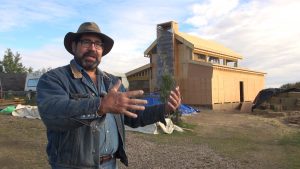
It’s boarded up right now, but Lance and Wendy Olson’s post and beam straw-bale home will feature a passive solar sun porch, solar thermal heating, solar PV electricity all in a compact 800 sq. ft. design near Battle Lake, Alberta. Photo David Dodge
Our last story is about a not-so-new way to build a super energy efficienct home—from straw.
“Being a musician, I’m always looking for a place where I can practice and teach that’s soundproof,” says Bumanis. “The builder approached me at a symphony concert and asked me if musicians were struggling with soundproofing in their homes. I said yes and he told me about this project and invited me to come take a look.”
“It’s warm in the winter, it’s cool in the summer, my highest heating bill has been $60 in the last six or seven years. It’s been really great,” says Bumanis.
Then we travelled to Buffalo Lake, Alberta to visit the dream home of Wendy and Lance Olson. They are building a straw-bale home and taking it all the way to net-zero, which means their home will generate more electricity than it will consume. The homes are beautiful and well worth a video tour if only to check out the Olson’s rammed earth walls or the harp music of Nora Bumanis, the harpist of the Edmonton Symphony Orchestra.
That’s it for our favourite stories of 2016. Thanks for reading. We’ll see you in 2017!

